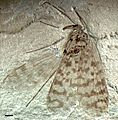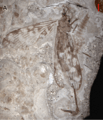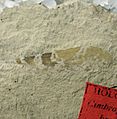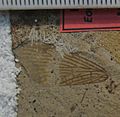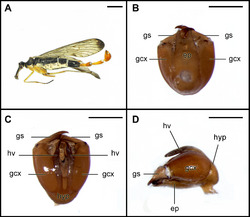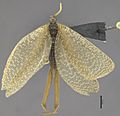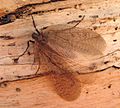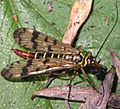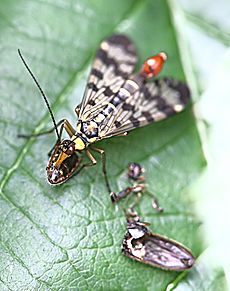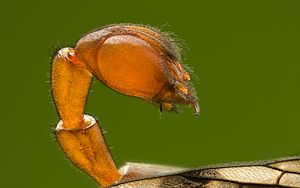Mecoptera
Quick facts for kids MecopteraTemporal range: Permian - Recent
|
|
|---|---|
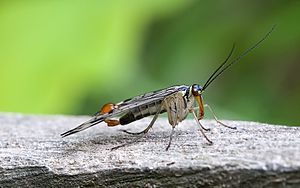 |
|
| Panorpa communis, male | |
| Scientific classification | |
| Kingdom: | |
| Phylum: | |
| Class: | |
| Superorder: |
Panorpida
|
| Order: |
Mecoptera
Hyatt & Arms, 1891
|
| Families | |
|
|
Mecoptera are a group of insects often called scorpionflies. Their name comes from the Greek words meco- (meaning "long") and -ptera (meaning "wings"). There are about 550 different kinds of Mecoptera found around the world.
They get the name "scorpionflies" because the males of their largest family, Panorpidae, have a part at the end of their body that looks like a scorpion's stinger. Don't worry, they can't sting you! Another well-known family is the Bittacidae, also called hangingflies. These long, thin insects are famous for their special ways of finding a mate. Female hangingflies often choose males based on how good the "gift" of prey the male offers them.
Contents
Evolution and History
Mecoptera are very important when we look at how insects have changed over time. Scientists believe that two big groups of insects, Lepidoptera (butterflies and moths) and Diptera (true flies), along with Trichoptera (caddisflies), might have come from ancestors that were very similar to Mecoptera.
We know this because these insects share similar body parts and even tiny chemical details inside their bodies. Also, we've found transitional fossils, which are like missing links, that show features of both Mecoptera and early flies. This tells us that Mecoptera were once much more common and diverse than they are today.
Ancient Scorpionflies and Pollination
Fossils show that Mecoptera have been around for a very long time, since the Permian period. Many different kinds of fossil Mecoptera have been found, especially from the Cretaceous period in places like China.
Some extinct Mecoptera species might have been important for pollinating early gymnosperm plants. These plants were mainly pollinated by wind, but fossil Mecoptera had special mouthparts that looked like a straw. They could have used these to drink nectar and eat pollen from these early plants, helping them to reproduce. Scientists have found eleven different species from three families that had these straw-like mouthparts.
These ancient scorpionflies probably moved pollen on their mouthparts and heads, much like bee flies and hoverflies do today. They likely helped pollinate plants that weren't very good at wind pollination or had structures that were perfect for these long-mouthed insects to feed from.
-
Miriholcorpa forcipata from the Middle Jurassic period in China
-
Forewing of Dinokanaga andersoni (Dinopanorpidae) from the Eocene period in Washington state
What Do They Look Like?
Mecoptera are usually small to medium-sized insects. They have a long "snout" or rostrum, see-through wings, and thin, long bodies. Their mouthparts are quite simple, with a long lower lip (labium), long jaws (mandibles), and fleshy feelers (palps). They also have large compound eyes on the sides of their heads and three small simple eyes (ocelli) on top. Their antennae are long and thin, made up of many small parts.
Both their front and back wings look similar. They are long and narrow with many small veins, a bit like the wings of very old insects such as mayflies. However, some types of Mecoptera have very small wings or no wings at all.
The body of the insect has eleven segments. The first segment is joined to the chest area. The end of the body often curves upwards in males, looking a bit like a scorpion's tail. This is where their enlarged reproductive parts are.
Their young, called larvae, look like small caterpillars. They have hard heads with jaws, short legs on their chest, and soft "prolegs" on their belly. The very last segment of their body has a suction cup or a pair of hooks. When they are ready to change, they become pupae. These pupae have their legs and other parts free, not stuck inside a cocoon.
How Many Kinds Are There?
Mecoptera can be anywhere from 2 to 35 millimeters (about 0.08 to 1.4 inches) long. There are about 600 known species alive today, grouped into nine families. Most of these species belong to the Panorpidae (common scorpionflies) and Bittacidae (hangingflies) families. Besides these, we know of about 400 fossil species, which show that there used to be even more variety in this insect group.
You can find Mecoptera all over the world. The most different types of species are found in Africa and Europe/Asia. However, there's more variety in the types of genera and families in North America, South America, and Australia. They are not found in places like Madagascar and many islands. This might mean they don't spread very easily to new places.
Where Do They Live and What Do They Eat?
Most Mecoptera like damp places, but a few can live in drier, semi-desert areas. Scorpionflies (family Panorpidae) usually live in forests with lots of damp leaves on the ground. Snow scorpionflies (family Boreidae) are special because they appear in winter! You can see them on snowfields and moss. Their larvae can even jump like fleas. Hangingflies (family Bittacidae) live in forests, grasslands, and caves where it's very humid.
Adult Mecoptera are mostly scavengers. This means they eat decaying plants and the soft bodies of dead insects. Some Panorpa scorpionflies are known to raid spider webs to eat insects caught there, and sometimes even the spiders themselves! Hangingflies are good hunters; they catch flies and moths using their specially shaped legs. Other groups of Mecoptera eat pollen, nectar, small worm-like midge larvae, dead animals (carrion), and bits of moss.
Because most Mecoptera need moist places, in very hot climates, the adults might only be active and visible for short times during the year.
Life Cycle
Female Mecoptera lay their eggs in damp places. The eggs usually soak up water and get bigger after they are laid. If it's very hot, the eggs might not hatch for several months, waiting until the dry season is over. More often, though, they hatch pretty quickly.
The larvae, as mentioned, look like small caterpillars. They have short, clawed legs and several soft prolegs on their abdomen. Their heads are hard with jaws, and they have compound eyes. The very last segment of their body has a suction cup or a pair of hooks. They usually eat plants or scavenge for dead insects, but some larvae are known to hunt other small creatures.
When a larva is ready to change, it crawls into the soil or decaying wood to become a pupa. It doesn't spin a cocoon. The pupae are "exarate," meaning their legs and other body parts are free and not stuck to the body. They can move their jaws, but they can't move around much otherwise. In dry places, they might stay in a resting state (called diapause) for several months. They only come out as adults when the conditions are just right.
Mecoptera and Humans
Sometimes, scorpionflies are used in forensic entomology. This is a science that uses insects to help solve crimes, for example, by studying insects found on human corpses.
People sometimes think scorpionflies look "sinister" or scary, especially because the male's raised "tail" looks like a scorpion's stinger. There's a common but incorrect belief that they can sting with their tails. Remember, they can't!
Images for kids
See also
 In Spanish: Mecoptera para niños
In Spanish: Mecoptera para niños



